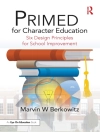‘This book will provide valuable assistance, organization, and vision to teachers for whom lesson planning is new or challenging!’
—Stephen M. Bongiovi, English Department Chair
Seaford High School, NY
‘I found myself engrossed, reading every word, and quite frankly, wishing for even more! Beyond a doubt, teachers will use this book!’
—Ronald W. Poplau, Instructor
Shawnee Mission Northwest High School, KS
‘A very useful addition to my teaching methodology! There is a need for this book.’
—J. Petrina Mc Carty-Puhl, Science Teacher
Robert Mc Queen High School, Reno, NV
Strengthen critical thinking skills with strategies that dramatically improve student performance!
Coauthored by two internationally renowned educators and researchers, this resource helps teachers strengthen their classroom practice with lessons that promote successful intelligence—a set of abilities that allow students to adapt and succeed within their environment, make the most of their strengths, and learn to compensate for their weaknesses.
The authors demonstrate how to design instructional units that help students apply successful intelligence to solve problems and make decisions. This research-based text also includes:
- Sample unit plans and 40 ready-to-use lessons illustrated with classroom examples
- Proven assessment techniques to promote the development of creative, analytical, and practical thinking skills
- Approaches to encourage both passive and active learning
With teacher reflection activities and suggested homework for students, this resource is ideal for strengthening students′ higher-order thinking abilities and raising overall academic performance!
Inhoudsopgave
Preface
Introduction
About the Authors
Part I. Understanding Successful Intelligence
1. What Is Successful Intelligence?
A Grizzly Bear′s Lunch
Defining Successful Intelligence
The Triarchy of Thinking Abilities
Conclusion
2. Examining the Theory of Successful Intelligence
Does Successful Intelligence Work in the Classroom?
Why Are Conventional Notions of Intelligence Still Prevalent?
3. Successful Intelligence in Life and in School
Successful Intelligence in Life: The Changing Demands of the Larger World
Successful Intelligence in School: Giving Everybody a Fair Chance
Part II. Building Successful Intelligence Abilities
4. Teaching for Analytical Thinking
Problem Solving
Lesson 1: Identify Problem
Lesson 2: Allocate Resources
Lesson 3: Represent and Organize Information
Lesson 4: Formulate Strategy
Lesson 5: Monitor Problem Solving Strategies
Lesson 6: Evaluate Solutions
Lesson 7: Additional Prompts for Analytical Thinking
5. Teaching for Creative Thinking
The Investment View of Creativity: Buying Low and Selling High
Balancing Analytical, Creative, and Practical Abilities
Lesson 8: Redefine the Problem
Lesson 9: Question and Analyze Assumptions
Lesson 10: Sell Creative Ideas
Lesson 11: Generate Ideas
Lesson 12: Recognize the Two Faces of Knowledge
Lesson 13: Identify and Surmount Obstacles
Lesson 14: Take Sensible Risks
Lesson 15: Tolerate Ambiguity
Lesson 16: Build Self-Efficacy
Lesson 17: Uncover True Interests
Lesson 18: Delay Gratification
Lesson 19: Model Creativity
Lesson 20: Additional Prompts for Creative Thinking
6. Teaching for Practical Thinking
Lesson 21: Become Motivated
Lesson 22: Control Impulses
Lesson 23: Persevere but Don′t Perseverate
Lesson 24: Use the Right Abilities
Lesson 25: Act on a Plan
Lesson 26: Become Oriented to Product
Lesson 27: Complete Tasks
Lesson 28: Make a Commitment
Lesson 29: Take a Risk
Lesson 30: Don′t Procrastinate
Lesson 31: Assign Responsibility
Lesson 32: Manage Self-Pity
Lesson 33: Be Independent
Lesson 34: Handle Personal Difficulties
Lesson 35: Concentrate
Lesson 36: Schedule Accordingly
Lesson 37: Set Priorities
Lesson 38: Balance Thinking Skills
Lesson 39: Develop Self-Confidence
Lesson 40: Additional Prompts for Practical Thinking
Part III. Developing Successful Intelligence Units
7. Framing Triarchic Instruction and Assessment Units
The Nuts and Bolts of TIA
What TIA Means
What TIA Does Not Mean
The Structure of TIA Units
Pre-TIA Activities
Designing a TIA Unit
Implementing TIA
8. Putting It All Together: A Comprehensive Illustration of Lessons for Teaching for Successful Intelligence
Introduction to Unit
Unit Lesson 1: Introduction
Unit Lesson 2: Analytical
Unit Lesson 3: Practical
Unit Lesson 4: Creative
Unit Homework
Unit Assessment
Conclusion
Appendix: Grade Level Activities
References
Index
Over de auteur
Elena Grigorenko is associate professor of child studies and psychology at Yale University and associate professor of psychology at Moscow State University. Grigorenko has published more than 200 peer-reviewed articles, book chapters, and books. She has received many professional awards, and her research has been funded by various federal and private organizations. Grigorenko has worked with children from around the world, including those living in Africa, Asia, Europe, and the Americas.












